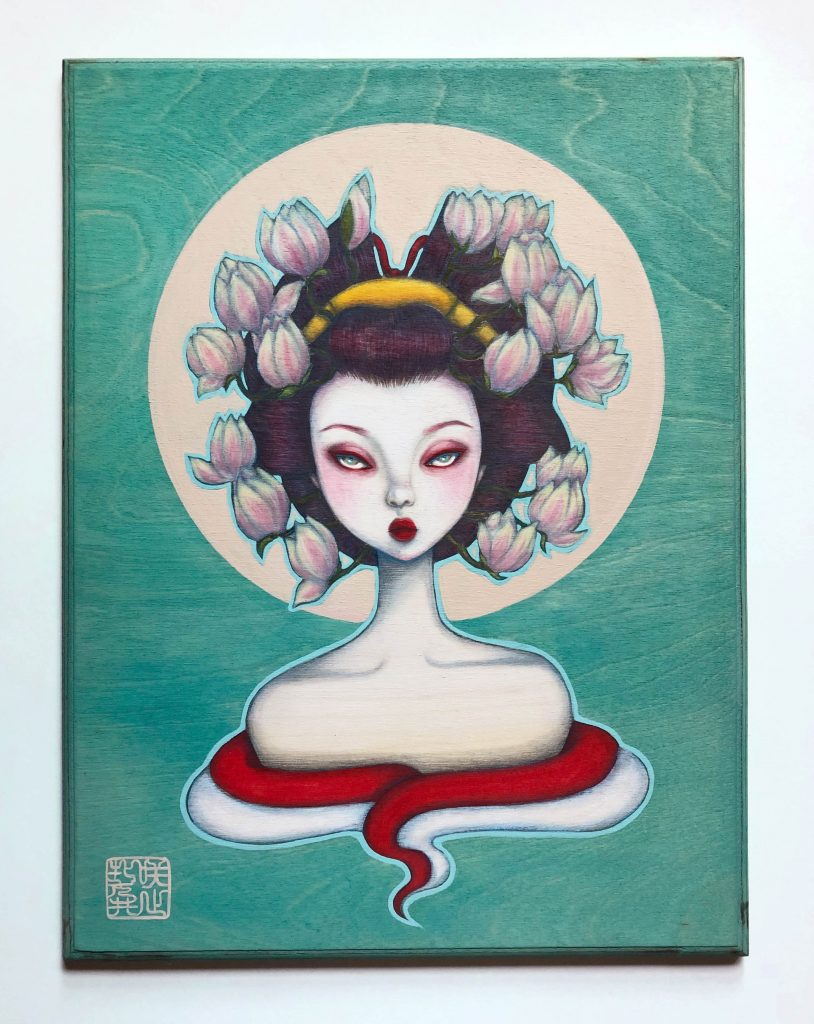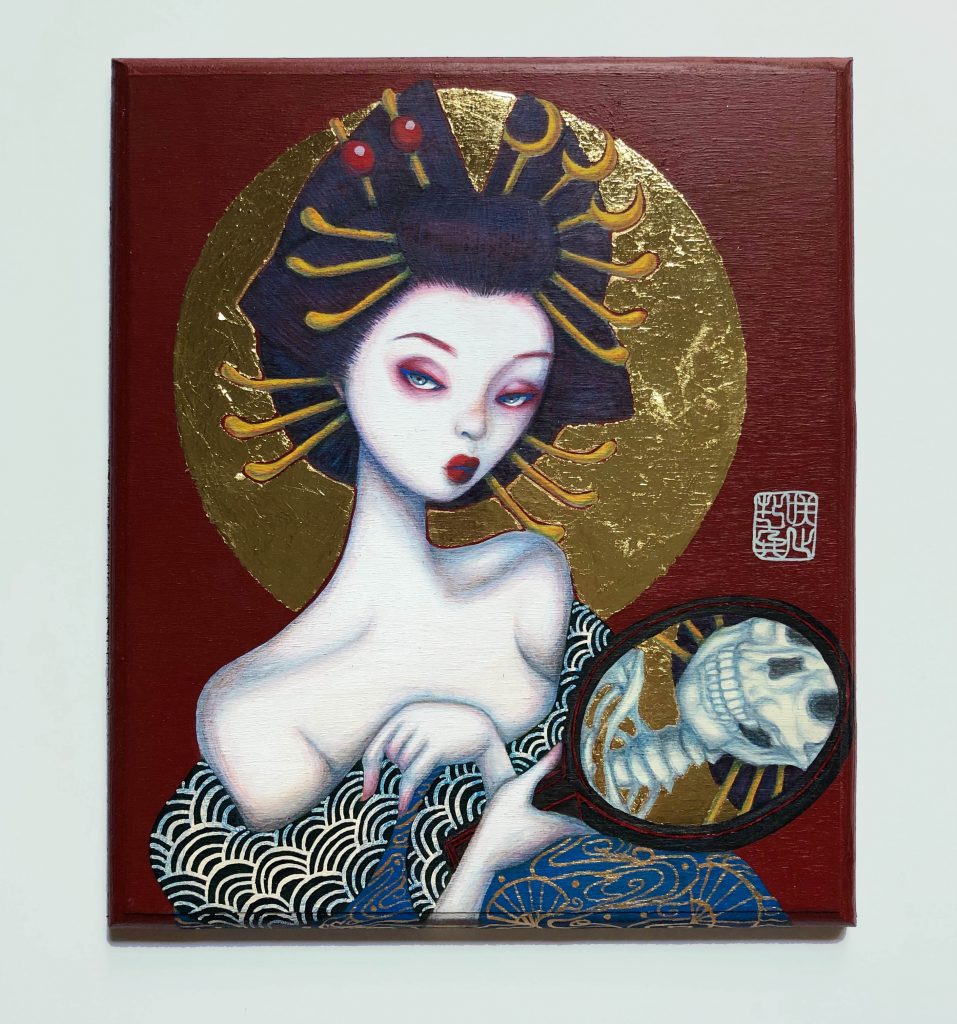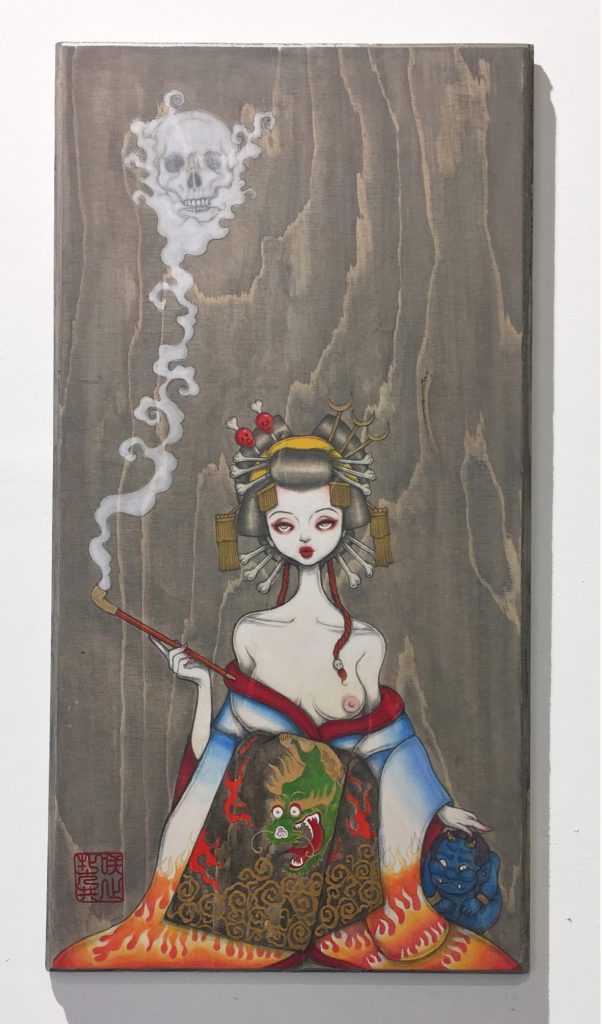
Mokulen, 2020 
Mirror Mirror, 2020
You’ve held two solo shows in 2018 and 2020 at Sway Gallery London, how did these come about?
SAKI: Sway Gallery had kindly contacted me to offer me show space. The first show (“Hana Machi”) went really well and so we decided to collaborate on another (socially distanced) exhibition called “Tayu Tau”. We’re hoping to plan a third one but… we’ll see.
Having started out in street art in 2009, you’ve since become well-known for other art forms and mediums, such as illustration and portraiture painting – was this a natural transition?
S: Yes, when I think about my art career, everything just happened naturally. At first, I wasn’t even thinking about becoming neither a street artist nor an artist, to be honest. I wasn’t trained and wasn’t aiming for it. Back then, I was hanging out in the big art studio off Brick Lane, and just started pasting small hand-drawn stickers around the area. Some street art photographers started taking photos of them, then I kind of thought, “Oh, am I doing street art?”
As time went by, I just wanted to make better things, so I got a studio and started painting big, naked ladies on plywood and screwed them to walls in East London. I had to end the plywood method when I lost that studio, as it’s too big to carry a big piece of wood and ladder from my flat! Around the same time, I met other street artists for the first time. They were/are all amazing and taught me how to spray and paint walls together.
The reasons why I moved to mainly “indoor painting” are 1. I am just so lazy like a house cat, I just love staying in and 2. I love to see my plans/visions come to life just as I had imagined them. By illustrating and painting on a small scale I can really take control of that. And I love the textures of mediums such as oil paint and wood, as well.
Vintage erotica, hypersexuality and tongue-in-cheek messaging are all signature SAKI&Bitches – how did underground East End aesthetics and Japanese sensibilities first come together in your art?
S: I started collecting sex cards from telephone boxes when I first moved to London. I thought it was quite funny, especially the wording; it’s mostly tongue-in-cheek. Then when I started to make the hand-drawn stickers, I was imitating those cards, so that was the beginning of SAKI&Bitches.
Also, I’ve always been a fan of the good ol’ pin-up style, so that again was my initial inspiration for S&B too. I really like female having fun out of own sexuality; not just looking super sexy, but also enjoying it and not taking sex and nudity too seriously. So, the first stage of S&B definitely had an ‘in your face’ sexual energy (if that even make sense, haha).
Around 2016-17, I started to see a different side to female sexuality. In this world, female sexuality can be vulnerable and sometimes easily exploited. As much as I adore a sex-positive female power, I also started to feel that I need to focus on the other side of it. And for the show at Sway Gallery in 2018, I picked the theme of Yujo / Edo period sex workers, searching and studying the history of them. I wanted to capture the beauty and sensibilities of those young sex workers in Yoshiwara, Tokyo. At the time it was a bit of a challenge for me, but I think through the making the show my new style came about.
So, now I think S&B has two styles, and I love to create them both.
Have you noticed any differences between Japan and the UK, when it comes to art and how it’s viewed or created?
S: I must say that I don’t know anything about the art world in Japan, as I only started my career when I moved to the UK. Though I do feel that the UK or London art/pop art scene is very open to new ideas. You might not make money but if you’re making something fun and fresh, you could at least have a chance to show it an audience. I was probably lucky that I’m Japanese and I was doing street art; that itself was already unique in London, so maybe helped to open more doors to me. I imagine that might be kind of hard in Japan.
You also explore ‘taboo’ subject matter in some of your work, like the sex industry. Is it important to you to open up this sort of dialogue through your art?
S: It’s not that important, to be honest. I mean, it’s not my goal anyway. Most of the time I don’t really make things as political or other statements. It might become one sometimes, it depends on the subject. But at the beginning, I don’t have a strong intention. I just simply choose the subject that I’m interested in and that might end up opening up some dialogue among audiences. That’s cool too, of course.
Even if I’m up for it or not, I’m stupidly curious about most subjects/ideas; I like to study and explore. And through research for my pieces, I’ve been learning about and inspired by a lot of different things in the world – good or bad – so, I guess painting is just for my own study and exploring my own mind.
The sex industry is definitely not a taboo thing to talk about for me, but I understand that in our society most people might not talk about or, if they do, it may be sensationalised. I just like to portray subjects I’m interested in as I see it and afterwards, we can always talk about it. If not, that’s totally fine by me too!
Your work showcases women, from the female form to empowerment – which figures or artists have had an impact on you or your work, if any? Who are you drawn to?
S: I’d say during the first stage of SAKI&Bitches, a lot of old pinup photos or drawings, and Rockin’Jelly Bean. He definitely inspired me a lot in the beginning… Erotic but fun, so totally my taste. Obviously I love the hypersexual figures of his but also I love his colours and ideas generally. And Katsuya Terada. I always admire his insane details and fluid lines. Even with a simple sketch, he can make it seem like a masterpiece.
The pandemic has hit the culture and creative industries hard. How have you been staying motivated and inspired during lockdowns? Has it changed the way you work?
S: To be honest, nothing much has changed when it comes to my work style and creation. I’ve always been inside and painting. But one thing I’ve been feeling more than ever is appreciation towards those who have been supporting me. Luckily, I managed to have a solo show at Sway Gallery right before the second lockdown last year, and people could come and see my work. It was amazing.
The fact that I can carry on what I’ve been doing, I am deeply grateful and it genuinely motivates me. It doesn’t matter what sells, just one little sticker motivates me to create better work.
Creative opportunities are becoming increasingly inaccessible and hard to come by, particularly now. Do you have any advice for those with no formal training in the arts, like yourself, who are finding it difficult?
It’s kind of hard to say, as I myself am still on the way to a somewhat stable career in art, haha. But I guess what I’d say to myself is – just stick to the one subject that you love and are interested in, polish your skills, and see what’ll happen.
Do you have any recommendations for those looking to find out more about little-known Japanese culture? (Comedy, music, film, books, art, brands, museum collections)
S: I’m so out of touch with any Japanese culture these days, to be honest…
So please send me any recommendations to sakiandb@gmail.com.
Finally, for a bit of fun – for those learning Japanese, can you tell us your favourite Japanese saying or expression?
S: Daijoubu! All good! I, or we, say a lot I think, and I like it. Really assuring and nice to use to others or to yourself. And ukiyo (uki = floating or fleeting and yo = world), which means ‘this transient life/world’. It’s very much my way of viewing life and this world; a beautiful saying, I think.
